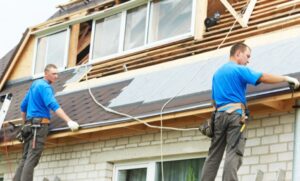Introduction
Owning a home is one of the biggest investments most people will make in their lifetime. However, maintaining and repairing a home can be expensive, especially for low-income homeowners. This guide aims to inform low-income homeowners about the various options available for obtaining loans or grants to repair and improve their homes.
Understanding Home Repair Loans and Grants
Home repair loans and grants are financial assistance programs offered by the government, non-profits, and private organizations to help low-income homeowners with home repairs. These programs aim to improve the safety, accessibility, and livability of homes for low-income individuals and families.
Types of Home Repair Loans
There are several types of home repair loans available for low-income homeowners:
- Home Improvement Loans: These loans are available to homeowners who need funds for general home repairs and improvements, such as roofing, plumbing, or electrical work.
- Energy-Efficient Mortgages (EEMs): EEMs are designed to help homeowners make energy-efficient upgrades to their homes. The cost of the upgrades is added to the existing mortgage.
- Section 504 Home Repair Program: This program offers loans to low-income homeowners over the age of 62 for home repairs that will make their homes safer and more accessible.
- Title I Property Improvement Loan Program: This program provides loans to homeowners who need funds for home improvements, but do not have enough equity in their homes to qualify for traditional loans.
Types of Home Repair Grants
Unlike loans, grants do not have to be repaid and are generally more difficult to obtain. However, they can be a great option for low-income homeowners who cannot afford to take on additional debt.
- USDA Rural Repair and Rehabilitation Grants: These grants are available to homeowners in rural areas who are 62 years of age or older and cannot afford necessary home repairs.
- Weatherization Assistance Program: This program offers grants to low-income households to improve the energy efficiency of their homes and reduce utility bills.
- Home Grants from Local Non-profits and Charities: Many local non-profit organizations and charities offer grants for home repairs to low-income homeowners in their communities.

How to Qualify for Home Repair Loans and Grants
The qualifications for home repair loans and grants vary depending on the program. However, in general, low-income homeowners must meet certain income requirements and have a credit score that meets the lender’s criteria.
Applying for Home Repair Loans and Grants
To apply for home repair loans and grants, homeowners will need to provide documentation such as proof of income, property ownership, and any necessary permits for the repairs. It is also essential to carefully review the application requirements and deadlines for each program.
Pros and Cons of Home Repair Loans and Grants
Like any financial decision, applying for home repair loans and grants has its own set of advantages and disadvantages. On the positive side, these programs can help alleviate the financial burden of costly home repair and improvements. They can help ensure that homes are safe, comfortable, and energy-efficient. However, there are also drawbacks to be aware of. Loans have to be repaid, and depending on the terms, they could potentially lead to financial strain. Additionally, the application process for both loans and grants can be complex and time-consuming, and there’s no guarantee of approval.
Conclusion
Home repair loans and grants can be a lifeline for low-income homeowners who need to make necessary repairs or improvements to their homes. By understanding how these programs work, the types available, and how to apply, homeowners can make an informed decision about whether these options are right for them. Remember, each program has its own set of requirements and procedures, so it’s important to do your research and consider consulting with a financial advisor or housing counselor to navigate this process effectively. So, if you are a low-income homeowner in need of assistance with home repairs, don’t hesitate to explore these options and see how they can benefit you and your family. Your home is an important investment, and it’s worth taking the time to ensure it remains safe, comfortable, and livable for years to come.
To read more articles visit Go News Time
